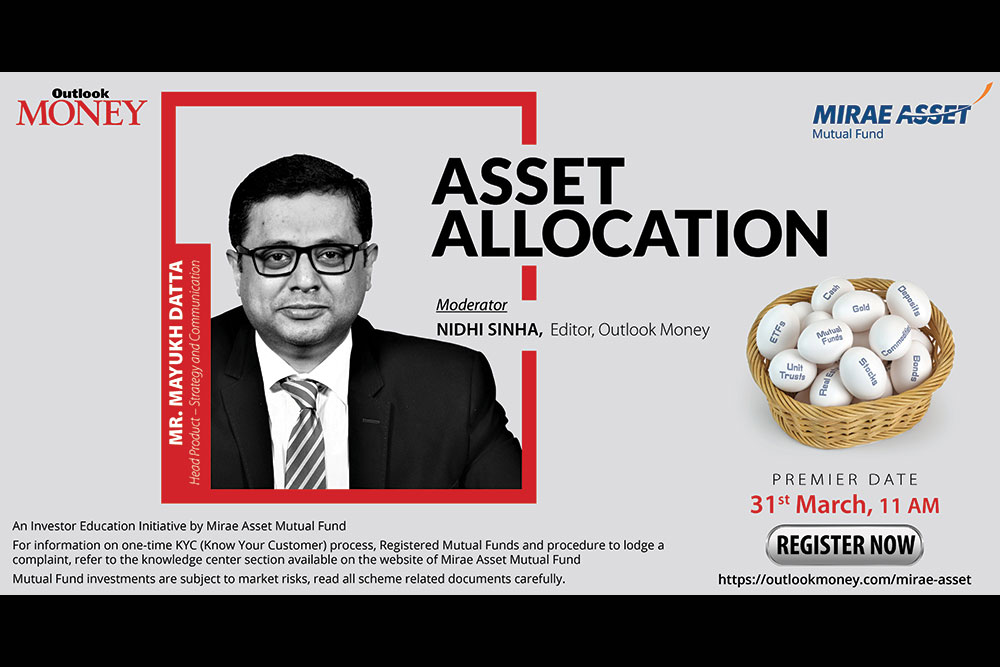TThe latest edition of the investor awareness and education webinar, spearheaded by Mirae Asset Mutual Fund and powered by Outlook Money, was on the importance of asset allocation for retail investors’ portfolios. In conversation with Nidhi Sinha, editor, Outlook Money, was Mayukh Datta, head product, strategy and communication, Mirae Asset Investment Managers Pvt Ltd. Here are the edited highlights of the discussion:
What Is Asset Allocation?
Asset allocation is where you have different investments into different investment vehicles with the purpose that the whole basket helps you achieve different goals. Put simply, no education is complete with only one subject. If that happens, no goal can be achieved. Similarly, an investment portfolio needs to have different parts that are meant for different objectives.
For example, for goals that are due in the next five to six months, the investment will be different, and for goals for which money is needed maybe 15-20 years from now, there will be a different set. Different objectives lead to different actions for which the investment needs to be made. Asset allocation also helps build a certain risk profile. Different investment allocations result in the accumulation of different asset classes because each asset class has a unique characteristic, which then aids in achieving goals.
Asset allocation is a personal exercise. Because each person’s requirements are different—depending on the income, age, social strata to which they belong and family background—the asset allocation strategy will differ in each case.
People sometimes club age groups together to create homogeneous strategies. For example, people who are slightly younger would have a longer investment horizon and can, therefore, look at allocation towards higher growth assets. But that’s only one way of looking at it. Age is a good starting point, but there are many other factors that should be taken into consideration.
Things To Keep In Mind
With the markets at high levels recently, a lot of people are gravitating towards equities. This attitude is called the recency bias, which means people tend to look at only recent performance of any asset class and base their investment decisions on that.
All asset classes go through their investment cycles, which is what makes asset allocation necessary. The choice of investment also depends on the need. Take the examples of someone who wants to retire in 20 years and another who wants to fund a child’s education and both need X amount. If both looked at the recent past and placed their investments, the results would be very different.
Looking at the time frame is important. Typically, for the equity asset class, the horizon should be five years and beyond because, historically, cycles are at least that long. Plus, compounding comes into effect over the long term. If it is a shorter time frame, it is advisable or prudent to check hybrid or debt funds.
A better way to deal with it would be to look at the goal and allocate accordingly. Knowing when it’s needed, how much is needed and for what purpose will help, not getting led on by a fad and deciding accordingly.
Typically, a rule of thumb would be that if your goal is five years and beyond, the percentage allocation towards equity or any growth-oriented asset class could be slightly higher.
Role of Mutual Funds
Hybrid and balanced funds are asset allocation products and invest in more than one asset class. But they don’t really help doing the overall asset allocation as investors would have other products such as Employees’ Provident Fund (EPF), Public Provident Fund (PPF) and fixed deposits.
A hybrid scheme is more about a rule-based way of investing where a fund will invest in more than one asset class in a certain proportion. If that rule or the ratio of investment helps achieve a certain goal, it’s great. But hybrid funds do have the tax advantage, offer convenience and ensure participation in asset allocation.
But it’s important to include other assets such as EPF and PPF in the basket when it comes to the overall asset allocation of the portfolio.
Besides, there are people who do look to manage volatility and for them hybrid funds are a good fit.

